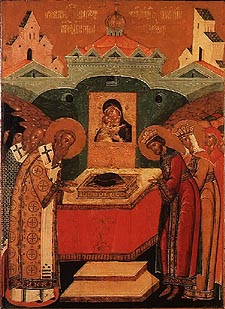|
|||
|---|---|---|---|
| This weekly bulletin insert complements the curriculum published by the Department of Christian Education of the Orthodox Church in America. This and many other Christian Education resources are available at http://dce.oca.org. | |||

Sometimes the Church commemorates together a saint and an event, both of which remind us of the central place in our theology of Mary the Theotokos. One such event is the "Placing of the Honorable Robe of the Most Holy Mother of God at Blachernae." It took place in the year 458 at the church in Blachernae, a suburb of Constantinople. The saint is Juvenal, who served as Patriarch of Jerusalem from 420 to 458. The story of the Theotokos' robe begins with two brothers from Constantinople named Galbius and Candidus. They set out for Palestine to venerate the holy places there, and near Nazareth they stayed with a devout elderly woman. She told them she'd been caring for a sacred item in her home: the Theotokos' robe. Near the end of her life, the Mother of God had given it to a pious maiden, and it had been passed down through generations of that maiden's family. Many people in ill health or distress, the elderly woman said, received healing by prayerfully touching the robe. Knowing the sacred relic belonged in a church, the brothers took it back with them to Constantinople and informed the Emperor and the Patriarch about it. In June of 458, it was placed in the Blachernae church, which is dedicated to the Mother of God. Almost 900 years later, a Russian pilgrim described seeing it: "We arrived at Blachernae, where the Robe lies upon an altar in a sealed reliquary." Saint Juvenal was an excellent theologian who attended both the Third and Fourth Ecumenical Councils. At the Third Council, in Ephesus, he insisted on the term "Mother of God" to describe Mary against those who claimed that she could only be called the mother of Christ. Giving her that diminished title, he argued, would be denying that Jesus is truly the Christ, both God and Man in one Person. Saint Juvenal had to defend the Church's teachings at both Councils, and did so successfully. But his opponents in Jerusalem continued to spread their wrong beliefs, and managed to have Juvenal removed from his position as Patriarch. They installed a man named Theodosius, who at first had the support of the empress Eudoxia. Fortunately she was convinced by Saint Simeon the Stylite to adhere to the Councils' decisions. Juvenal's position was restored, and he served the Jerusalem church as patriarch for 38 years. These events correspond with Jesus' own words about seeking the truth. He says, "The queen of the South will rise up at the judgment with this generation and condemn it, because she came from the ends of the earth to listen to the wisdom of Solomon, and see, something greater than Solomon is here!" (Matthew 12: 42).
The Queen of Sheba made a great effort to hear truth from Solomon. God has given us ways to know the truth, too. Those at the Councils used their God-given minds to work out that Mary is rightly called Mother of God because her Son is the Divine and Human Savior. God also gave us a tangible proof of Mary's holiness: a Robe that drew people to Christ by healing and renewing His people. |
|||
